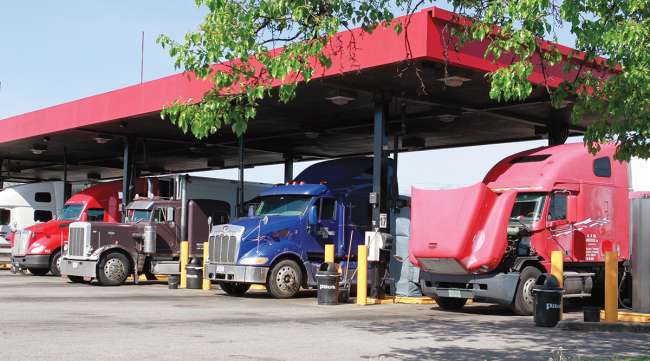Senior Reporter
Report Urges Trucking Regulators to Evaluate Fuel-Efficiency, GHG Emissions Standards

[Stay on top of transportation news: Get TTNews in your inbox.]
A new study by the National Academy of Sciences urges federal regulators to conduct an “interim evaluation” of the federal medium- and heavy-duty truck Phase 2 greenhouse gas and economy rule with an eye toward more stringent standards.
The 439-page second and final Phase 2 report, made public Oct. 18, covers a range of new technologies and issues focused on the 2022-30 time frame, and offers suggestions to improve fuel consumption and greenhouse gas emissions that likely can be achieved, the report concluded.
The study said that medium- and heavy-duty vehicles are a significant contributor to energy consumption and greenhouse gas emissions in the transportation sector, accounting for approximately 22% of U.S. transportation energy consumption.

“Implementation of new propulsion technologies, new low-carbon fuels, and more efficient freight operations and logistics offer the opportunity to reduce fuel consumption and GHG emissions beyond what is achievable from improving the efficiency of conventional medium and heavy vehicles — which may be necessary to meet future climate goals,” the report said.
The Phase 2 joint Environmental Protection Agency and National Highway Traffic Safety Administration rule, published in October 2017, regulates trucks and their engines in three stages: 2021, 2024 and 2027.
Among the report’s recommendations:
- NHTSA, in cooperation with EPA, should establish what medium- and heavy-truck greenhouse gas fuel-consumption reductions need to be achieved in the 2030 to 2050 time frame, consistent with national goals and international agreements to which the United States is a party.
- Engine manufacturers, with appropriate engagement of NHTSA and EPA, should allow and promote use of biodiesel and renewable diesel in their engines. NHTSA, in concert with EPA, is encouraged to continue some types of incentives for use of biomass-derived diesel fuel, provided that analyses continue to show overall life-cycle GHG reduction.
- Medium- and heavy-duty truck fuel-consumption standards should include expectations for weight-reduction adoption, with the likely potential for 3-4% reduction in load-specific fuel consumption at market-acceptable return on investment.
- Government and industry should continue the development of higher efficiency spark-ignition gasoline and natural gas engines for vocational vehicles and should continue to ensure substantial CO2 and fuel consumption reductions are realized, because higher efficiency appears feasible, and market forces may cause a shift toward spark-ignition engines.
- For Class 8 combination tractor-trailers, a total weight reduction of at least 4,000 pounds appears achievable, depending on duty cycle.

The report also said that NHTSA and EPA will have almost a decade between the Phase 2 and a possible Phase 3 rulemaking in which to coordinate with other governmental and private entities to collect real-world vehicle data that can be used to establish a reliable baseline. The agencies should commit resources to collecting real-world fuel consumption and GHG emissions data from a robust and representative sample of pre-control trucks and for each model year subject to Phase 1 and Phase 2 standards.
“These data can be used to establish a regulatory baseline that can be used to evaluate program effectiveness and future regulatory priorities,” the Academy said.
Vehicle speed is another important factor, with higher vehicle speeds resulting in greater fuel consumption needed to transport a given load a specified distance. As a result, many fleet owners are installing speed limiters on their vehicles to require lower speeds and save money through fuel conservation.
“Another important factor is driver behavior, as inefficient driver behavior can result in significant fuel wastage,” the report said. “Many vehicle owners are now using telematics and surveillance technologies to monitor driver behavior, creating sensitive tensions between optimal performance and driver privacy.”
Road condition and traffic management also can dramatically affect fuel efficiency, the report said.
Want more news? Listen to today's daily briefing:




